Download PDF
Download page Computational Level Output (Troubleshooting).
Computational Level Output (Troubleshooting)
Computational Log File
Sometimes a 2D sediment model will crash without iteration or other useful information in the runtime window.
The runtime window only provides information on they hydraulic iterations. It does not include information on sediment iterations. But you can access sediment convergence and critical cell information to help troubleshoot a model like this. The image below includes an example of a single time-step result from a default computational log file (with three grain classes). By default (sediment output "Level 3"), the computational log file includes information on the final convergence criteria for concentration and active layer gradation, for each grain class, at the end of each time step.
The file will only reflect the input parameters unless you request computational level output. To turn on the computational level output select Options → Output Options from the Plan editor and choose the Computation Level Output Options tab. 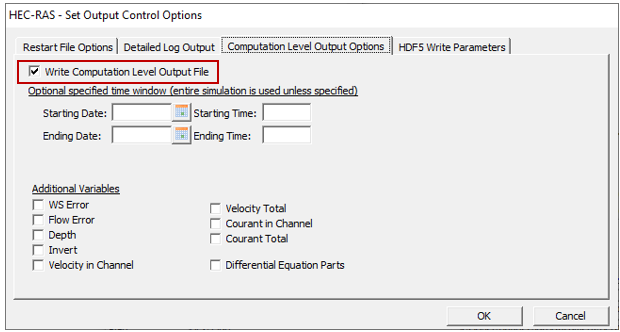
To access the Computational log file, select Options → View Computational Log File from the Plan editor. 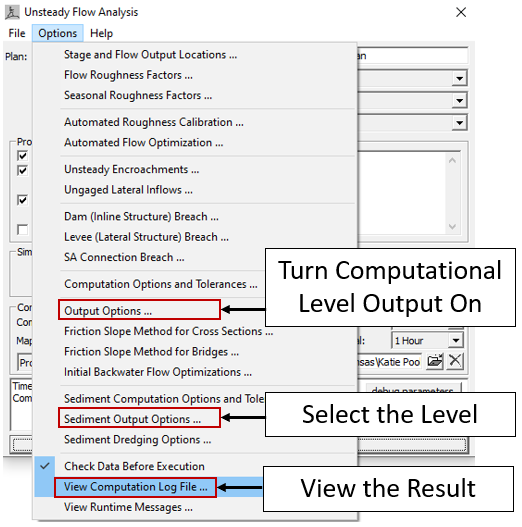
Controlling the Computational Log File
Users can control two aspects of the computational log file that affect the amount of data it includes: the time step and the "Output Level." This is a simple text file and it can get very large, so you can use these controls to optimize the tradeoff between useful information and file size.
First, this file writes to the Mapping Output Interval. You will get results at this time step.
Second, the "Sediment Output Level" controls the amount of data included in this file. You can se the Output Leve by navigating to Options→ Sediment Output Options in the Plan editor. The default output level ("3") includes the final convergence results for concentration and active bed fractions for each grain class, the end of each Mapping Output Interval. It also lists the convergence status and the cell with the larges error during that time step.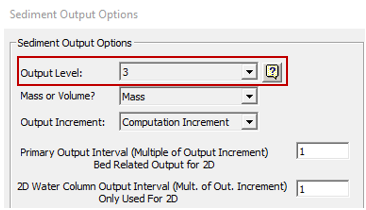
Higher levels include information on the sub-iterations of each Mapping Output Interval.
Interpreting the Computational Log File
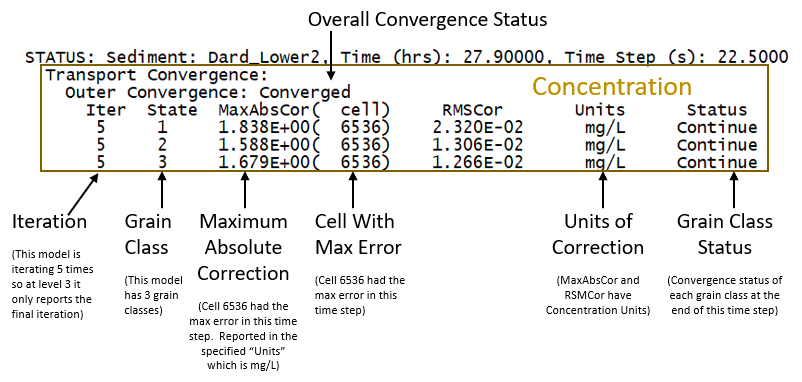
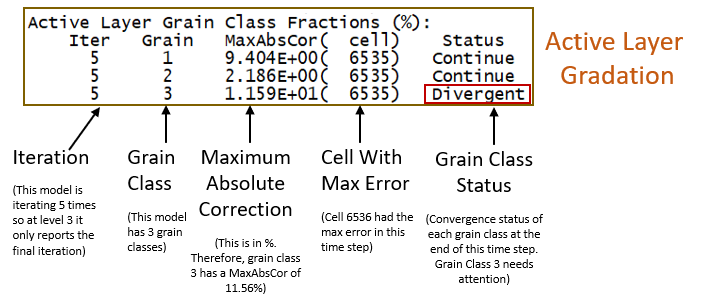
At output level 3 the Computational Log file generates the output pictured above for concentration and active layer gradation at the end of each Mapping Output time step. For higher output levels, HEC-RAS will write this same information at the end of each iteration within the time step (e.g. the result above has five iterations so it would generate five of these results per time step). The log file reports results by grain class and provides the Maximum Absolute Correction and the Root Mean Squared Correction. (Note: In sediment "correction" is the same as "error" in hydraulics. It is just the difference between the solution at the beginning and end of the iteration). The Max Absolute is spatial, it reports the cell with the biggest difference between the beginning and end of the iteration. The MaxAbsCor is in mg/L for concentration and % for gradation. This file also reports the cell with the largest error (like the runtime window does The RSMCor is a more general diagnostic. It reports a root mean squared value of the differences between results at the beginning and end of the simulation for all cells so you can tell how the model is converging on average.
Finally, each grain class gets one of four designations to indicate its convergence status at the end of the time step (Output Level 3) or the iteration (Output Levels >3). These are described below.
| Status | Definition |
|---|---|
| Converged | The solution at the end of the iteration is within the convergence tolerance of the result of the previous iteration. However, if the other grain classes have not converged, it will continue to iterate because the grain classes are coupled. |
| Continue | This grain class did not reach the criteria by the end of the iteration but did not diverge. The model will carry over the best result to the next time step. |
| Iterating | The grain class has it hasn't converged yet but it hasn't reached max iterations yet. (Will only show up in intermediate iterations, not the final - so this should never show up for "Level 3 or lower"). |
| Divergent | The grain class not only did not converge but the difference increased until it reached some large divergence criteria (e.g. 100X the initial solution). This grain class is unstable for this time step. |